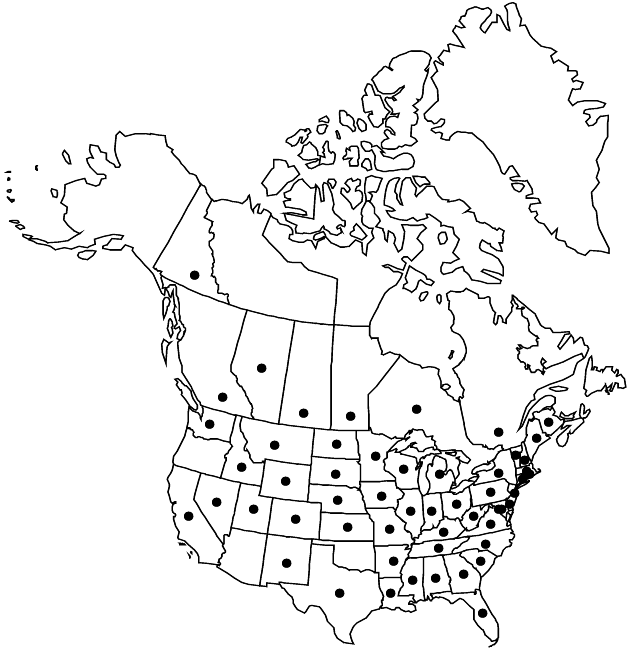Difference between revisions of "Symphyotrichum laeve"
Taxon 31: 359. 1982.
FNA>Volume Importer |
FNA>Volume Importer |
||
| Line 77: | Line 77: | ||
|publication year=1982 | |publication year=1982 | ||
|special status= | |special status= | ||
| − | |source xml=https://jpend@bitbucket.org/aafc-mbb/fna-data-curation.git/src/ | + | |source xml=https://jpend@bitbucket.org/aafc-mbb/fna-data-curation.git/src/f50eec43f223ca0e34566be0b046453a0960e173/coarse_grained_fna_xml/V19-20-21/V20_1133.xml |
|tribe=Asteraceae tribe Astereae | |tribe=Asteraceae tribe Astereae | ||
|genus=Symphyotrichum | |genus=Symphyotrichum | ||
Revision as of 20:23, 16 December 2019
Perennials (15–)20–70(–120) cm, cespitose; stoutly short-rhizomatous, with thick, woody caudices or a few, long rhizomes. Stems 1–5+, erect (straight, glaucous, sometimes reddish proximally), glabrous, sometimes sparsely hirsute distally. Leaves (glaucous) thick, firm, ± fleshy, margins crenate-serrate or -serrulate or entire, scabridulous, apices mucronulate, faces glabrous; basal usually withering by flowering or sometimes persistent (var. purpuratum), petiolate (petioles ± winged, bases dilated, sheathing), blades spatulate or oblong to ovate or lanceolate-ovate, 30–200 × 10–25(–30) mm, bases attenuate or cuneate to rounded, margins crenate-serrate to serrulate, apices acute to obtuse or rounded; proximal cauline often withering by flowering, petiolate or subsessile or sessile (petioles narrowly to broadly winged, clasping), blades ovate or oblong-ovate to lanceolate or linear-lanceolate, sometimes ± panduriform, (40–)80–150(–180) × (10–)20–45 mm, bases attenuate to rounded or ± shallowly auriculate-clasping, margins entire or shallowly crenate-serrate, minutely scabrous, apices acute or obtuse, callus-pointed; distal sessile, blades lance-ovate or lanceolate to linear, 7–45 × 1–14 mm, progressively reduced distally (abruptly so in arrays), bases auriculate and ± clasping to rounded, margins entire. Heads in broad, sometimes ± flat-topped, paniculiform arrays, branches stiffly ascending (rarely arching), leafy with small, gradually reduced branch leaves. Peduncles 0.2–6+ cm, glaucous, glabrous or puberulent in lines, bracts 3–6, densely spaced, subulate or linear-lanceolate to linear, subclasping, apices sometimes purplish, grading into phyllaries. Involucres campanulate to cylindro-campanulate, (4.2–)5–7(–8) mm. Phyllaries in 4–6 series, appressed, subulate or lanceolate (outer) to oblong-lanceolate or linear-lancolate or -oblanceolate, unequal (sometimes appearing subequal), bases indurate 1/2–3/4, margins scarious, erose, hyaline, ciliolate distally, green zones mostly diamond-shaped to ± lanceolate (some inner, or most in var. geyeri), apices acute to acuminate, sometimes ± obtuse, red-mucronate or apiculate, faces glabrous. Ray florets (11–)13–23(–34); corollas usually pale to dark blue or purple, seldom white, laminae (6–)7.2–11.3(–14.6) × 1.5–2.5 mm. Disc florets (17–)19–33(–43); corollas yellow turning purplish red, 3.5–6.1 mm, tubes slightly shorter than funnelform throats, lobes triangular, (0.4–)0.6–1 mm. Cypselae deep purple to brown, oblong-obovoid, compressed, 2–3.5 mm, 4–5-nerved, faces glabrous or glabrate; pappi tawny to red- or rose-tinged, 5–7 mm.
Distribution

North America, ne Mexico, introduced in other areas of Mexico, Central America, Europe.
Discussion
Varieties 4 (4 in the flora).
Selected References
None.
Lower Taxa
Key
| 1 | Leaves lanceolate to ovate, conspicuously auriculate-clasping, lengths less than 5 times widths | > 2 |
| 1 | Leaves linear-lanceolate to linear, slightly auriculate-clasping, lengths often 5 times widths | > 3 |
| 2 | Phyllaries strongly unequal, green apical zones diamond-shaped | Symphyotrichum laeve var. laeve |
| 2 | Phyllaries unequal, green apical zones lanceolate | Symphyotrichum laeve var. geyeri |
| 3 | Basal leaves withering by flowering, cauline linear-lanceolate | Symphyotrichum laeve var. concinnum |
| 3 | Leaves mostly basal and proximal at flowering, mostly linear | Symphyotrichum laeve var. purpuratum |